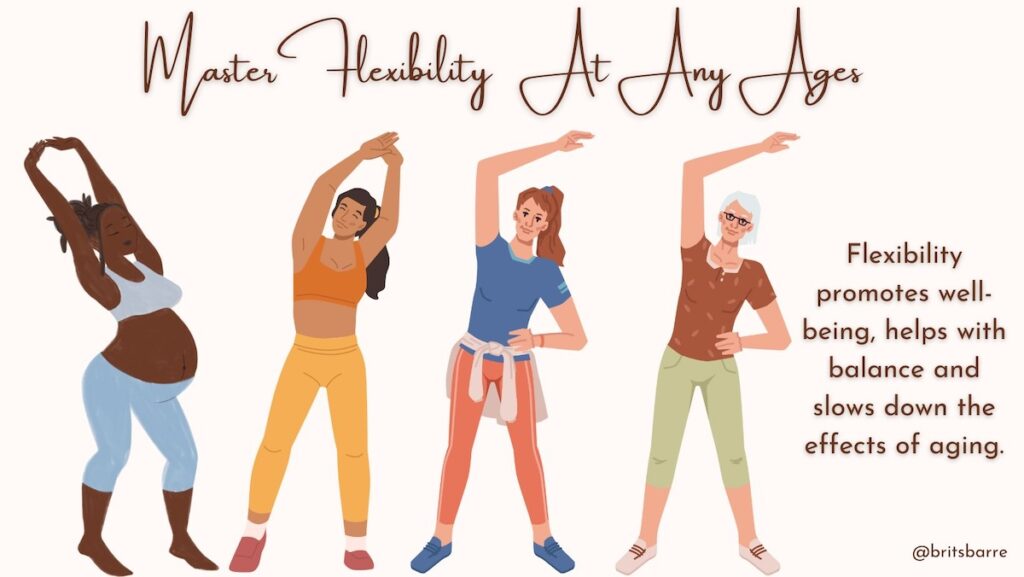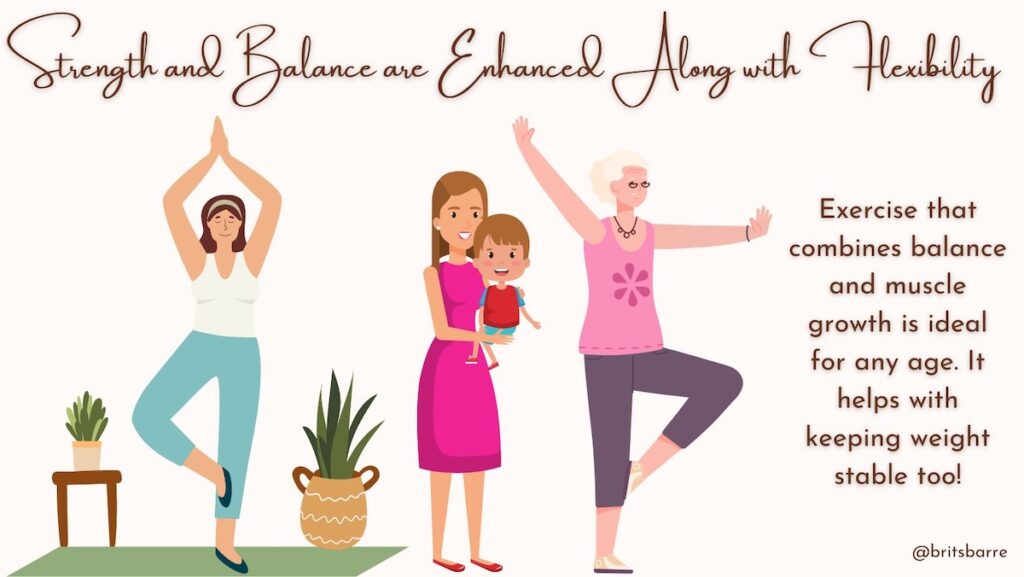Flexibility and age. In all its forms, it is a critical aspect of our well-being that often doesn’t receive the attention it deserves. Whether you’re in your energetic 30s, transitioning through your 40s and 50s, or embracing the golden years of the 60s and beyond, the importance of cultivating flexibility—physical, mental, and emotional—cannot be overstated.
Starting at any age, working on flexibility can dramatically improve your quality of life, helping you manage stress, maintain physical health, and adapt to life’s ever-changing circumstances. This guide underscores the significance of flexibility through the decades and offers practical tips for integrating it into your life, no matter your starting point.

Flexibility in Your 30s – Laying the Foundation
The 30s are a time of growth and challenge, where establishing a flexible routine can have profound long-term benefits. Here’s why starting now is crucial:
- Stress Management: Physical and mental flexibility can help manage career and personal life pressures. Stretching and flexibility exercises slow us down and create calm in our day.
- Injury Prevention: Regular stretching can prevent the aches and injuries from an increasingly sedentary lifestyle.
- Growth and Adaptability: Taking time to stretch and relieve stress fosters creativity and problem-solving, crucial for navigating life’s challenges.
- Long-Term Wellbeing: Early habits set the stage for health and happiness well into the future.
- Enhances Stamina: The demands of being a young parent and juggling a career call for as much energy and stamina as possible!
Prioritizing flexibility in your 30s lays a strong foundation for a healthy, fulfilling life. It equips you to handle stress better, prevent injuries, and adapt to life’s ups and downs with grace and resilience.
The 40s – Balancing Act
The 40s are often marked by increased responsibilities and the onset of physical signs of aging, making flexibility more important than ever:
- Combatting Physical Aging: Regular flexibility exercises can help mitigate the effects of aging, keeping the body youthful and agile.
- Chronic Condition Management: Activities like yoga, Pilates, and Barre exercises can stave off conditions like back pain, arthritis, and computer-related aches and pains.
- Maintaining Equilibrium: Flexibility is key in managing the body’s aging changes and helps your balance.
- Pursuing Fulfillment: Staying flexible added to the energy needed to explore new interests and maintain personal well-being.
In your 40s, flexibility is key to balancing life’s demands with personal health and happiness. It allows you to maintain your physical health and adapt to changes with a more energetic outlook.
Embracing Change in Your 50s
As you enter your 50s, embracing change becomes pivotal, with flexibility playing an important role in navigating this decade:
- Mobility and Balance: Tailoring your exercise regimen to include flexibility-focused activities can greatly enhance your quality of life and support your health goals.
- Adjusting to Life Transitions: Physical and mental flexibility helps adapt to new life stages, such as family dynamics, career shifts, and fun activities.
- Health and Vitality: Keeping the body flexible is key to managing the natural aging process and staying active.
- Redefining Life: This is a prime time for exploring new passions and adjusting to life goals with an open and flexible mindset.
Your 50s can be a time for reassessment and adaptation, with flexibility adding to the quality of life in navigating this transformative period. It’s about staying physically active and mentally open to new opportunities and changes.
The 60s and Beyond – Flourishing with Flexibility
In the ’60s and beyond, flexibility becomes paramount in maintaining independence, health, and enjoyment of life:
- Functional Independence: Regular flexibility routines can help you maintain the ability to perform daily activities and enjoy hobbies.
- Fall Prevention: Improved balance and flexibility are critical for preventing falls, a major concern in later years.
- Adapting to Change: An adaptable mindset allows for continued personal growth and learning and positively embraces life’s changes.
- Continued Engagement: Flexibility enables ongoing participation in various activities and travel and fosters a sense of connection and joy.
As you journey into the 60s and beyond, flexibility offers a pathway to a vibrant, active life. It supports physical health, encourages adaptability, and enables you to engage fully with the world around you.

The Lifelong Journey of Flexibility
Starting at any age, cultivating flexibility is a profound commitment to enhancing one’s quality of life. It’s about more than just physical health; it’s about developing the resilience and adaptability to face life’s challenges with grace and optimism. Each decade brings challenges and opportunities, and flexibility is the key to navigating them successfully.
Whether you’re laying the foundation in your 30s, balancing life’s demands in your 40s and 50s, or embracing the golden years of the 60s and beyond, flexibility is your companion on the path to a fulfilling, vibrant life.
A mere 30 minutes of barre exercise is a brilliant and fun way to increase flexibility and strength. Try our complimentary online classes for a week! Follow this link to get your free week.
